|
|
| |
|
|
| |
|
|
|
|
| |
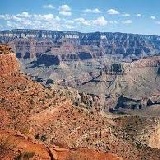 Travel
America Travel
America
Learn before you travel. This section of Fun Easy
English focuses on facts and other cool stuff about
your favorite U.S. state. This is great English
reading practice. This page focuses on the state of
Colorado. |
 Hey
if you cannot understand something on this page, Hey
if you cannot understand something on this page,
then use the Fun Easy English
dictionary
(opens in a new window) |
|
|
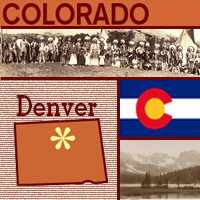 Colorado Colorado
Called the "Centennial State," because it became the
38th state when the U.S. turned 100 in 1876,
Colorado is most closely associated with the Rocky
Mountains and has numerous peaks over 14,000 feet.
The state's name comes from a Spanish word meaning
"red" or "ruddy," the color of much of the state's
terrain. Today, Colorado is known for its vast
cattle ranges, agricultural acreage, and
snow-covered mountains that are ideal for winter
sports. Its capital is Denver and state flower is
the Rocky Mountain columbine. |
|
Colorado
State Flag
The Colorado state flag consists of three equally
sized stripes; the outer stripes are the same color blue as
the national flag, separated by a white center stripe. There
is a large semi-circular "C" on the flag, which is the same
shade of red as the U.S. national flag. In the opening of
the letter "C" there is a gold disc.
The colors in Colorado's flag represent the environmental
features of the state. White symbolizes the snow on her
mountains, gold acknowledges the abundant Colorado sunshine,
red represents Colorado's red soil, and blue is a symbol of
her clear blue skies. Colorado has flown many flags - three
countries and eight Territories have laid claim to (and
flown their flags over) what is now the state of Colorado. |
|
Source:
State Symbols USA |
|
|
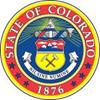 Colorado
State Facts Colorado
State Facts
Picture: state seal of Colorado |
|
State Capital |
Denver |
|
Nickname |
Centennial State |
|
Motto |
Nil Sine Numine (Nothing without Providence) |
|
Statehood |
August 1, 1876 (38th) |
|
Origin of Name |
From the Spanish for the color red, which was
applied to the Colorado River. |
|
Largest Cities |
Denver, Colorado Springs, Aurora, Lakewood, Fort
Collins |
|
Border States |
Arizona, Kansas, Nebraska, New Mexico, Oklahoma,
Utah, Wyoming |
|
Area |
103,730 sq. mi.; 8th largest |
|
State Bird |
Lark Bunting |
|
State Flower |
Rocky Mountain Columbine (aquilegia caerules) |
|
State Tree |
Colorado Blue Spruce (picea pungens) |
|
State Song |
Where the Columbines Grow |
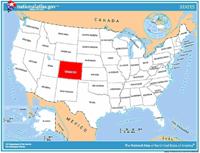 Travel and tourism site
for Colorado - This state travel and territorial
tourism site provides ideas for your vacations, meetings, and more. Travel and tourism site
for Colorado - This state travel and territorial
tourism site provides ideas for your vacations, meetings, and more. |
|
|
Colorado Stories |
|
|
Cinco de Mayo
Did you know that Colorado used to be owned by Spain? In the early
1700s the area that is now Colorado was claimed by Spain, and
eventually France controlled most of it. Later, in 1803, the Eastern
part of Colorado became part of the Louisiana Purchase (a deal
between France and the U.S.), with the rest remaining in Spanish,
and later, Mexican, control until 1848.
In Denver, Colorado, and many other cities, people of Hispanic and
Mexican descent have a Cinco de Mayo festival with storytelling,
parades, food, and dancing to the beat of salsa and mariachi music.
Cinco de Mayo is Spanish for the Fifth of May. On this day in 1862
Mexican peasants won a battle against French invaders in Puebla,
Mexico. Many people mistake Cinco de Mayo for Mexican Independence
Day, but that happened on September 16, 1810 -- more than 50 years
earlier.
This Hispanic celebration began in Denver in 1987 as a small
neighborhood street festival. By 1996 the weekend event had become
so large -- attracting a half-million festival-goers -- that it
moved to its new home in Denver's Civic Center Park. Does your city
have a Cinco de Mayo celebration? The next time you have the
opportunity, go and help celebrate! |
|
|
The Denver March Powwow
Every year American Indians have a powwow in Denver, Colorado, that
attracts people from all 50 states and 14 countries. A powwow is a
social gathering of Indian peoples to honor their heritage that has
been passed down through generations. More than 80 Indian tribes
come to the Denver March Powwow to celebrate their history and
culture through arts and crafts, storytelling, music and dance.
There are many different types of powwow dances. During InterTribal
dancing, everyone from all the different tribes and all age groups
dance together. Even though they are dancing as a group, each dancer
moves independently to the beat of the drum - expressing his or her
own feelings and creating a unique style.
Other dances include the Men's Traditional Dance. This is the oldest
form of Indian dancing, and historically only the warriors were
allowed to dance in a circle. This dance is a form of storytelling
in which the men act out things they have done in battles or on a
hunt. In the Women's Jingle Dress Dance, women wear dresses with
"jingles" on them and dance in a sort of side-step around a sick
person in order to help cure him. |
|
|
Bolder Boulder Race in Boulder, Colorado
Just like the story about the little train that could, if you think
you can, you can. If you can walk, run or wheel, you can take part
in the "Oh Yes You Can" race in Boulder, Colorado.
Every year on Memorial Day, Boulder, Colorado, hosts the Bolder
Boulder 10K road race. This race is open to everyone and includes a
wheelchair race and a walkers' race. It also includes Marine Corps
units who march to honor fallen American soldiers. This is the
fourth largest road race in the world and the one of the largest
tributes to American veterans in the U.S. on Memorial Day.
Because the race is so big, organizers needed to figure out a way to
include everyone and still have an official race. So they came up
with the idea of the "wave." Runners are placed in "waves," groups
of up to 900 people, with staggered start times. Faster runners are
put in the first waves and slower ones are placed in the following
waves. A new wave is started every one to two minutes, and the start
and finish times for the runners in each race are recorded. This way
everyone gets to race without the slower runners getting in the way
of faster ones. Have you ever been in a race that had "waves"? |
|
|
Colorado's Rocky Mountains
Many people know that the Rocky Mountains make up an enormous chain
of mountains in western North America that extends 3,000 miles from
Canada through the United States to Mexico. But did you know that
the tallest mountain in Colorado, part of the Rocky Mountains, is
called Mount Elbert, which is 14,433 feet high?
The Rocky Mountains form the Continental Divide, the mountainous
ridge that runs north to south along North America and causes water
to drain in separate rivers flowing to different sides of the
continent. Eventually, these rivers lead to the Atlantic and Pacific
Oceans as well as the Gulf of Mexico.
In 1915, Congress designated some of this mountainous area in
Colorado as Rocky Mountain National Park. The tallest mountain in
this park is Longs Peak, which is 14,256 feet high. |
|
|
Olathe Sweet Corn Festival in Colorado
Can sweet corn save a town? It can if that town is Olathe, Colorado!
The town of Olathe used to grow sugar beets and barley, but by the
late 1970s those crops weren't in much demand anymore. The town fell
on hard times because it depended upon the success of the farmers to
survive. Then a farmer named Dave Galinet, who had developed several
varieties of sweet corn, decided to move his business to the Olathe
area. Olathe had the ideal climate for growing sweet corn - hot days
and cool nights. Soon after that, many of the other farmers started
to grow sweet corn too, and before long the town was prosperous
again.
Olathe decided to celebrate the fact that it was thriving, and what
better way than to have a sweet corn festival? The first festival
was on a rainy day in August 1992. And guess what? More than 800
people showed up. Nowadays about 20,000 people come to the festival.
And you know what they get to do? Eat all the sweet corn they want.
In 1999, participants ate 70,000 ears of "Olathe Sweet" donated by
the growers. Can you imagine how many people there were to eat that
many ears of corn? |
|
|
Western Welcome Week in Littleton, Colorado
Whether or not the clown in the picture lives in Littleton,
Colorado, or is just visiting, he will always be welcome there.
That's because if you have ever lived in or visited Littleton you
are invited every year to come back for a "homecoming."
The people of Littleton like their community so much they have a big
party each year that they call Western Welcome Week. About 1,200
volunteers help organize a circus, parade, fireworks, and more for
families and the community to enjoy during this 10-day event.
Houstoun Waring, the longtime editor of the Littleton Independent,
founded Western Welcome Week in 1929 as a way to promote the city.
His idea was to celebrate the 100th birthday of city founder Richard
S. Little with a "Homecoming." Originally Homecoming was set for May
12, 1929, Little's birthday, but when it was pointed out that
railroad rates dropped in August and people could come from far away
for less money, they changed the date to August, which is when the
event is held today. |
|
|
The 4th of July in Colorado
Many American cities have rodeos but Greeley, Colorado, has the
"Worlds' Largest Fourth of July Rodeo." The city was named after
Horace Greeley, a well-known newspaperman for the New York Tribune.
One of his famous sayings was "Go west, Young Man, go west." In
1869, he sent one of his reporters west to Colorado to write a story
about farming. The reporter, Nathan C. Meeker, liked the area so
much he stayed and started a town named after his boss. It was
Meeker's vision that helped establish a successful community based
on, among other qualities, cooperation, agriculture, irrigation, and
education.
Every year the people of Greeley celebrate Independence Day with a
rodeo. In the early days, the rodeo was a small local event, but it
grew more and more popular. In 1922, more than 10,000 people came to
the rodeo, and the town officially named the event the "Greeley
Fourth of July Celebration and the Spud Rodeo and Horseshow." They
called it the spud rodeo because spuds (another name for potatoes)
are an important crop grown around Greeley. A few years later, even
more people came to the rodeo, when famous cowboys started competing
with the local ranch hands. Today, the rodeo lasts for two weeks and
is called the Greeley Independence Stampede. |
|
Source:
Library of Congress |
|
 National
Parks, National
Forests, Parks, and Monuments of Colorado National
Parks, National
Forests, Parks, and Monuments of Colorado
The following is a description of national
forests, parks, and monuments in the state
of Colorado. If you plan to visit or live in
Colorado for awhile then you should
definitely plan to visit some of these
fantastic places. |
|
|
|
National Forests |
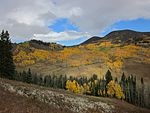 Arapaho Arapaho
Arapaho National Forest is in the high
Rockies and includes six wilderness areas.
It is currently managed jointly with
Roosevelt National Forest and Pawnee
National Grassland. The highest paved road
in North America ascends Mount Evans at an
elevation of 14,265 ft (4,348 m). |
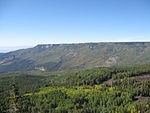 Grand
Mesa Grand
Mesa
In western Colorado, Grand Mesa National
Forest covers part of Battlement Mesa and
most of Grand Mesa, the largest flattop
mountain in the world with an average
elevation of 10,500 ft (3,200 m). There are
over 300 lakes in the forest. It is managed
together with Gunnison National Forest and
Uncompahgre National Forest. |
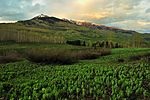 Gunnison Gunnison
Gunnison National Forest is located in the
Rocky Mountains near Gunnison, Colorado.
Among the seven wilderness areas in the
forest are the Maroon Bells-Snowmass
Wilderness. The Slumgullion Slide is a giant
landslide due to the mineral montmorillonite. |
 Manti-La
Sal Manti-La
Sal
Including the La Sal and Abajo mountains of
eastern Utah, elevations in this forest
reach 12,721 ft (3,877 m) on Mount Peale.
The Dark Canyon Wilderness is the only
wilderness area in the forest. This national
forest is also partially located in the
state of Utah. |
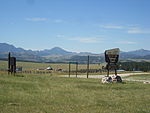 Medicine
Bow – Routt Medicine
Bow – Routt
This forest contains many ranges of the
Rocky Mountains with elevations ranging from
5,500 ft (1,700 m) to 12,940 ft (3,940 m).
There are ten wilderness areas and Rob Roy
Reservoir, which covers 500 acres (200 ha).
This national forest is also partially
located in the state of Wyoming. |
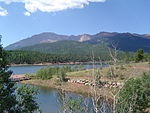 Pike Pike
Pike National Forest includes Pikes Peak at
an elevation of 14,115 ft (4,302 m) and
three wilderness areas. Since 1975 the
forest has been managed together with San
Isabel National Forest. |
 Rio
Grande Rio
Grande
The headwaters of the Rio Grande are in the
San Juan Mountains in the western part of
the forest, while the Sangre de Cristo
Mountains form the eastern boundary.
Elevations reach 14,345 ft (4,372 m) at the
summit of Blanca Peak, overlooking the San
Luis Valley and Great Sand Dunes National
Park. |
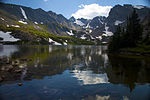 Roosevelt Roosevelt
Located in the Rocky Mountains of northern
Colorado, Roosevelt National Forest has part
of six wilderness areas. It is managed
together with Arapaho National Forest and
Pawnee National Grassland. |
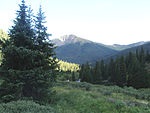 San
Isabel San
Isabel
There are 19 of Colorado's 54 fourteeners in
San Isabel National Forest, including the
highest point, Mount Elbert at 14,440 ft
(4,400 m). The forest includes the Sawatch
Range, Collegiate Peaks, and Sangre de
Cristo Range and is managed together with
Pike National Forest. |
 San
Juan San
Juan
San Juan National Forest includes Chimney
Rock National Monument and elevations that
range from 5,000 ft (1,500 m) to over 14,000
ft (4,300 m). The forest's Weminuche
Wilderness is the largest in Colorado at
499,771 acres (202,250 ha). |
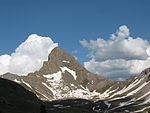 Uncompahgre Uncompahgre
The northern portion of the San Juan
Mountains and the Uncompahgre Plateau are
located in this National Forest. The forest
also contains Uncompahgre Gorge and three
wilderness areas. |
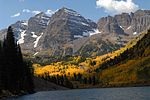 White
River White
River
White River National Forest has eight
wilderness areas, twelve ski resorts, four
large reservoirs, 2,500 mi (4,000 km) of
trails, 1,900 mi (3,100 km) of roads, and
ten peaks higher than 14,000 ft (4,300 m) in
elevation. |
|
|
|
National Parks |
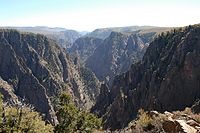 Black
Canyon of the Gunnison Black
Canyon of the Gunnison
The park protects a quarter of the Gunnison
River, which slices sheer canyon walls from
dark Precambrian-era rock. The canyon
features some of the steepest cliffs and
oldest rock in North America, and is a
popular site for river rafting and rock
climbing. The deep, narrow canyon is
composed of gneiss and schist which appears
black when in shadow. |
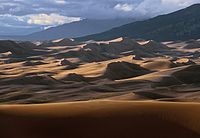 Great
Sand Dunes Great
Sand Dunes
The tallest sand dunes in North America, up
to 750 feet (230 m) tall, were formed by
deposits of the ancient Rio Grande in the
San Luis Valley. Abutting a variety of
grasslands, shrublands, and wetlands, the
park also has alpine lakes, six 13,000-foot
mountains, and old-growth forests. |
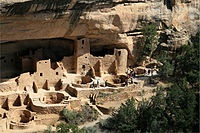 Mesa
Verde Mesa
Verde
This area constitutes over 4,000
archaeological sites of the Ancestral
Puebloan people, who lived here and
elsewhere in the Four Corners region for at
least 700 years. Cliff dwellings built in
the 12th and 13th centuries include Cliff
Palace, which has 150 rooms and 23 kivas,
and the Balcony House, with its many
passages and tunnels. |
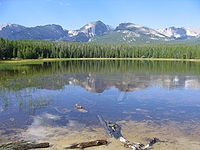 Rocky
Mountain Rocky
Mountain
Bisected north to south by the Continental
Divide, this portion of the Rockies has
ecosystems varying from over 150 riparian
lakes to montane and subalpine forests to
treeless alpine tundra. Wildlife including
mule deer, bighorn sheep, black bears, and
cougars inhabit its igneous mountains and
glacial valleys. Longs Peak, a classic
Colorado fourteener, and the scenic Bear
Lake are popular destinations, as well as
the historic Trail Ridge Road, which reaches
an elevation of more than 12,000 feet (3,700
m). |
|
|
|
National Monuments |
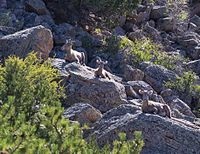 Browns
Canyon Browns
Canyon
Protects 21,500 acres of steep cliffs and
colorful rock outcroppings overlooking the
Arkansas River in Chaffee County, Colorado,
as well as the area's rich native history. |
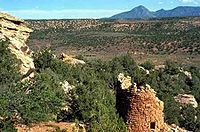 Canyons
of the Ancients Canyons
of the Ancients
Surrounding Hovenweep National Monument, it
preserves and protects more than 6,000
archeological sites, the largest
concentration in the U.S. |
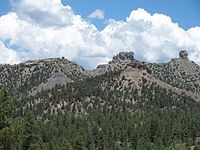 Chimney
Rock Chimney
Rock
The jewel of San Juan National Forest, the
site was once home to the ancestors of the
modern Pueblos. Roughly 1,000 years ago, the
Ancestral Pueblo People built more than 200
homes and ceremonial buildings high above
the valley floor. |
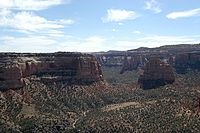 Colorado Colorado
Monument Canyon runs the width of the park
and includes rock formations formed by
erosion. The monument includes 20,500 acres
(83 km2) of semi-desert land high on the
Colorado Plateau and has a wide range of
wildlife including pinyon pines, juniper
trees, ravens, jays, desert bighorn sheep,
and coyotes as well as a range of
recreational activities. |
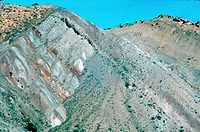 Dinosaur Dinosaur
This sandstone and conglomerate bed, known
as the Morrison Formation, was formed in the
Jurassic Period and contains fossils of
dinosaurs including Allosaurus and various
long-neck and long-tail sauropods. This
national monument is also partially located
in the state of Utah. |
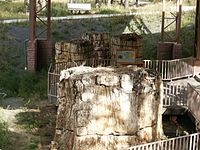 Florissant
Fossil Beds Florissant
Fossil Beds
Huge petrified redwoods and incredibly
detailed fossils of ancient insects and
plants reveal a very different landscape in
Colorado of almost 35 million years ago in
the Eocene age. |
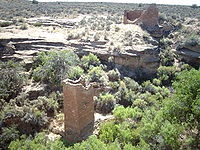 Hovenweep Hovenweep
Hovenweep contains six clusters of Native
American ruins. Holly Canyon, Hackberry
Canyon, Cutthroat Castle and Goodman Point
are in Colorado and Square Tower and Cajon
are in Utah. Ancient Pueblo Peoples lived in
the Hovenweep area from 1150 to 1350. This
national monument is also partially located
in the state of Utah. |
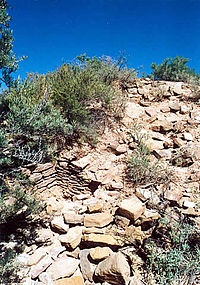 Yucca
House Yucca
House
Designated a research national monument, it
is a large, unexcavated Ancestral Puebloan
archeological site. The site is one of many
Ancestral Puebloan village sites located in
the Montezuma Valley occupied between AD 900
and 1300. |
|
|
|
|
Travel America |
|
|
Black Canyon National Park
(Beginner - Listening,
reading)
A video lesson which shows you an interesting place in America.
The English is
spoken at 75% of normal speed.
Great English listening and reading practice.
This video is all about Black Canyon National Park. |
Great Sand Dunes National Park
(Beginner - Listening,
reading)
A video lesson which shows you an interesting place in America.
The English is
spoken at 75% of normal speed.
Great English listening and reading practice.
This video is all about Great Sand Dunes National Park. |
Rocky Mountain National Park
(Beginner - Listening,
reading)
A video lesson which shows you an interesting place in America.
The English is
spoken at 75% of normal speed.
Great English listening and reading practice.
This video is all about Rocky Mountain National Park. |
|
|
|
|
|
|
|
|
Cool America |
 About the U.S.A. About the U.S.A.
About the U.S.A. is an American
Studies reader that examines the customs, government, and history of the
United States of America. The text provides a wealth of information on U.S.
geography and history; the roles of local, state, and federal government;
national holidays and symbols; the Constitution; and citizenship. The book,
which was written for intermediate to advanced learners of English, contains
a range of activities for language students to practice listening, speaking,
reading, and writing. (opens to a new PDF window)
Great English reading
practice. |
 About
America About
America
Learn about the fascinating history and government of
the United States of America. Lessons include content on
American Government, American History, and Integrated
Civics. Handouts with interactive games and
student-centered activities encompass all four language
skills: speaking, listening, reading, and writing.
Great English reading practice for
beginning to intermediate students. |
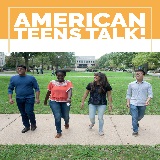 American Teens Talk! American Teens Talk!
Americans Teens Talk! is a collection of interviews of
American high school students. Each interview is accompanied by vocabulary
notes and discussion questions. The interviews in American Teens Talk! give
learners a view into the lives of adolescents in the U.S. Through the
written format of the interviews, learners are able to increase their
vocabulary, practice their reading and listening skills, engage in
discussions, and learn more about U.S. culture. These
interviews come with audio programs.
Great English listening and
reading |
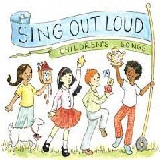 Sing Out Loud Children's Songs Sing Out Loud Children's Songs
Sing Out Loud Children's Songs includes popular children's songs in the U.S.A. Posters accompany the
individual Sing Out Loud Children's Songs. These
songs come with audio programs.
Great English listening and reading
practice. |
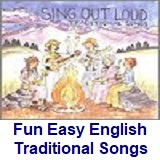 Sing Out Loud Traditional Songs Sing Out Loud Traditional Songs
The Sing Out Loud Traditional Songs
collection contains 13 traditional American folk songs and song lyrics.
Listen to the songs online, read the lyrics, and collect the posters that
accompany the songs. These
songs come with audio programs.
Great English listening and reading
practice. |
 Sing Out Loud American Rhythms Sing Out Loud American Rhythms
Do you love music? Want to use it
to learn English? Check out the hip-hop inspired song "Peace" from Sing Out
Loud American Rhythms. American Rhythms includes a variety of musical genres
from many different artists in the U.S.A. These songs will appeal to teens
and young adults. These
songs come with audio programs.
Great English listening and reading
practice. |
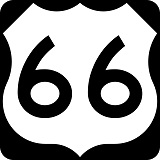 Route
66 - Famous American Road Route
66 - Famous American Road
U.S. Route 66 (US 66 or Route 66), also known as the Will Rogers Highway, the
Main Street of America or the Mother Road, was one of the original highways in
the U.S. Highway System. The highway, which became one of the most famous roads
in the United States, originally ran from Chicago, Illinois, through Missouri,
Kansas, Oklahoma, Texas, New Mexico, and Arizona before ending in Santa Monica,
California, near Los Angeles, covering a total of 2,448 miles (3,940 km). It was
recognized in popular culture by both the hit song "(Get Your Kicks on) Route
66" and the Route 66 television show in the 1960s. |
Route 66: The Highway That's the Best
(Beginner - Listening)
A video lesson which shows you an interesting place in America.
The English is
spoken at 75% of normal speed.
Great English listening practice.
This video shows travel along Route 66, the most famous road in
America. |
Chicago: The Start of Route 66
(Beginner - Listening)
A video lesson which shows you an interesting place in America.
The English is
spoken at 75% of normal speed.
Great English listening practice.
This video shows travel along Route 66, the most famous road in
America. |
Going West for Decades on Route 66
(Beginner - Listening)
A video lesson which shows you an interesting place in America.
The English is
spoken at 75% of normal speed.
Great English listening practice.
This video shows travel along Route 66, the most famous road in
America. |
Arizona: The Spirit of Route 66
(Beginner - Listening)
A video lesson which shows you an interesting place in America.
The English is
spoken at 75% of normal speed.
Great English listening practice.
This video shows travel along Route 66, the most famous road in
America. |
Route 66 California: The End of the Trail
(Beginner - Listening)
A video lesson which shows you an interesting place in America.
The English is
spoken at 75% of normal speed.
Great English listening practice.
This video shows travel along Route 66, the most famous road in
America. |
Ten Must-See Route 66 Attractions
(Beginner - Listening)
A video lesson which shows you an interesting place in America.
The English is
spoken at 75% of normal speed.
Great English listening practice.
This video shows travel along Route 66, the most famous road in
America. |
Four Famous Foods On Route 66
(Beginner - Listening)
A video lesson which shows you an interesting place in America.
The English is
spoken at 75% of normal speed.
Great English listening practice.
This video shows travel along Route 66, the most famous road in
America. |
International Tourists Drawn to Route 66
(Beginner - Listening)
A video lesson which shows you an interesting place in America.
The English is
spoken at 75% of normal speed.
Great English listening practice.
This video shows travel along Route 66, the most famous road in
America. |
|
|
|
|
Search Fun Easy English |
|
|
|
|
|
|
|
|
|
|
|
|
|
|
|
About
Contact
Copyright
Resources
Site Map |